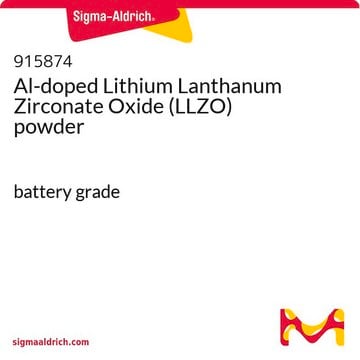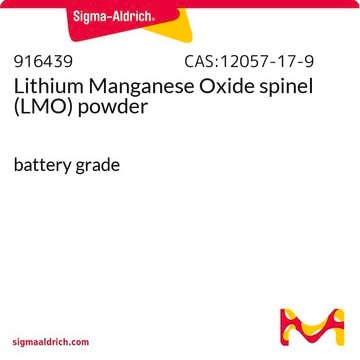916137
Lithium phosphorus sulfur chloride (LPSCl) powder
battery grade
Sinónimos:
Argyrodite solid electrolyte
About This Item
Productos recomendados
grado
battery grade
Nivel de calidad
Análisis
≥99.5%
formulario
powder
mol peso
Mw 268.40 g/mol
composición
Li6PS5Cl
conductividad
0.01-0.1 mS/cm (ionic conductivity, cold-pressed pellet at room temperature)
densidad
1.64 g/cm3 (lit.)
aplicaciones
battery manufacturing
Categorías relacionadas
Descripción general
Aplicación
Características y beneficios
- High Ionic Conductivity
- Consistent Particle Size
- Wide Electrochemical Window
- Compatible with Lithium Metal Anodes
Producto relacionado
Palabra de señalización
Danger
Frases de peligro
Clasificaciones de peligro
Acute Tox. 3 Oral - Acute Tox. 4 Inhalation - Aquatic Acute 1 - Eye Dam. 1 - Flam. Sol. 1 - Skin Corr. 1B - Water-react 1
Riesgos supl.
Código de clase de almacenamiento
4.3 - Hazardous materials which set free flammable gases upon contact with water
Clase de riesgo para el agua (WGK)
WGK 3
Punto de inflamabilidad (°F)
Not applicable
Punto de inflamabilidad (°C)
Not applicable
Certificados de análisis (COA)
Busque Certificados de análisis (COA) introduciendo el número de lote del producto. Los números de lote se encuentran en la etiqueta del producto después de las palabras «Lot» o «Batch»
¿Ya tiene este producto?
Encuentre la documentación para los productos que ha comprado recientemente en la Biblioteca de documentos.
Nuestro equipo de científicos tiene experiencia en todas las áreas de investigación: Ciencias de la vida, Ciencia de los materiales, Síntesis química, Cromatografía, Analítica y muchas otras.
Póngase en contacto con el Servicio técnico












